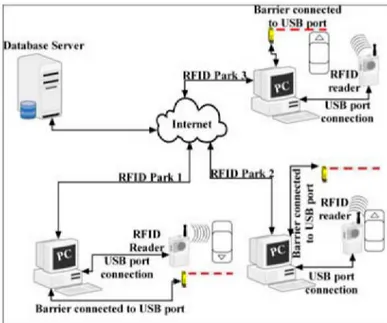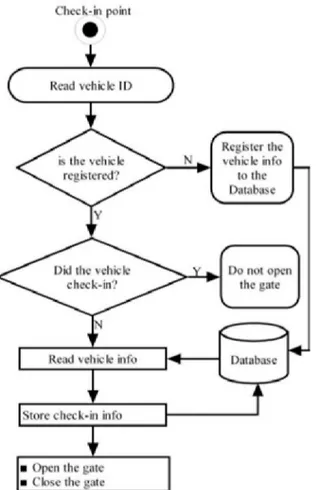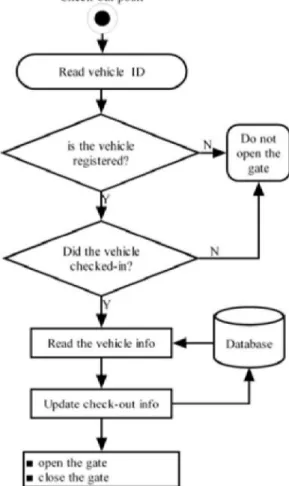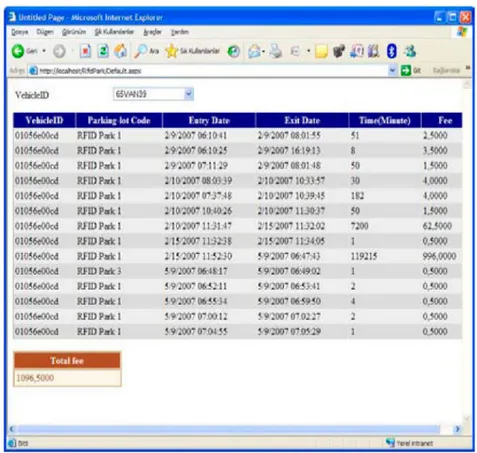2 (2), 2008, 235-245
©BEYKENT UNIVERSITY
AUTOMATION WITH RFID TECHNOLOGY
AS AN APPLICATION: PARKING LOT
CIRCULATION CONTROL
Zeydin PALA
Yuzuncu Yil University,
Özalp Vocational School, Comp. Prog. Dept., Van, Turkey,
e-mail: zeydinpala@yyu.edu.tr
Nihat İNANÇ
Yuzuncu Yil University,Electrical and Electronics Engineering Dept., Van, Turkey
e-mail: ninanc@yahoo.com
Received: 12 January 2008, Accepted: 11 February 2008
ABSTRACT
There has been a considerable amount of reduction in transaction costs and decrease in stock shortage with the use of Radio Frequency Identification (RFID) technology in automation. Most of the RFID networks include a wide range of automation technologies. These technologies are RFID readers, RFID writers, RFID barcode scanners, RFID smart sensors and RFID controllers. In this study, a solution has been provided for the problems encountered in parking-lot management systems via RFID technology. RFID readers, RFID labels, computers, barriers and software are used as for the main components of the RFID technology. The software has been handled for the management, controlling, transaction reporting and operation tasks for parking lots located on various parts of the city. Check-ins and check-outs of the parking-lots will be under control with RFID readers, labels and barriers. Personnel costs will be reduced considerably using this technology. It will be possible to see unmanned, secure, automized parking-lots functioning with RFID technology in the future.
Check-ins and check-outs will be handled in a fast manner without having to stop the cars so that traffic jam problem will be avoided during these processes. Drivers will not have to stop at the circulation points and parking tickets will be out of usage during check-ins and check-outs. It will be avoided ticket-jamming problems for the ticket processing machines as well. Vehicle owners will not have to make any payments at each check-out thus a faster traffic flow will be possible. Since there won't be any waiting during check-ins
and check-outs the formation of emission gas as a result of such waiting will be avoided. An automized income tracking system, a car tracking system for charging and a central parking-car tracking system have been developed and utilized. Instead of cars' parking on streets, a more modern and a fast operating parking-lot system have been developed.
Keywords: RFID, Automation, Parking-Lot
ÖZET
RFID (Radio Frequency Identification) teknolojisinin otomasyonda kullanılması ile işlem maliyetleri büyük oranda düşmüş ve stok açıkları azalmıştır. RFID ağlarının birçoğu; geniş çaplı otomasyon teknolojisi içermektedirler: Bunlar; RFID okuyucular, RFID yazıcılar, RFID barkot tarayıcılar, RFID akıllı sensörler ve RFID kontrolcüler olarak sıralanabilir. Bu çalışmada; bir şehrin otopark işletme sorununa RFID teknolojisi ile çözüm aranmaya çalışılmıştır. Bu çalışmada materyal olarak; RFID teknolojisini meydana getiren RFID okuyucular, RFID etiketler, bilgisayarlar, bariyerler ve yazılım kullanılmıştır. Yazılım ile; şehrin bir çok yerindeki otoparkın merkezi bir veritabanı çerçevesinde otomatik olarak işletilmesi, kontrol edilmesi, yönetilmesi ve raporlanması yapılmıştır. RFID okuyucular, etiketler ve bariyerler ile de; otopark giriş ve çıkış kontrolleri yapılmıştır. RFID teknolojisi ile oluşturulan bir otopark otomasyonunda; personel maliyetinin önüne geçilmiştir. İnsansız, güvenli ve tamamen otomatik olarak işletilebilen otoparklardan söz etmek mümkün olmuştur. Araçların durmalarına gerek kalmadan giriş ve çıkışlar hızlı bir şekilde yapılmıştır. Böylece giriş ve çıkışlarda trafik sıkışıklığının önüne geçilmiştir. Giriş ve çıkışlarda sürücüler camları indirmek ve önceki kontrol sistemleri gibi girişte fiş alıp çıkışta fişi vermek zorunda kalmamaktadır. Ayrıca; biletli geçişlerde olduğu gibi etiketlerin cihazda sıkışması tarzında bir sorun da yaşanmamaktadır. Araç sahipleri; her çıkışta para ödemek zorunda olmadıkları için gereksiz beklemeler kalkmış ve trafik akışı hızlanmıştır. Giriş ve çıkışlarda beklenme yaşanmadığından emisyon gazının da önüne geçilmiştir. Otomatik gelir takibi, araç borç takibi ve merkezi araç takibi yapılmıştır. Araçların caddelerde park edilmesi yerine daha modern ve hızlı işletilebilen otoparklar ön plana çıkarılmıştır.
I. INTRODUCTION
RFID is a technology that helps to identify the animate or inanimate through radio waves.
RFID is one of the most fundamental technologies that enables wireless data transmission. Although it has been known for a long time, has not been very often used in industry. Because it was expensive and there was no standardization among the manufacturing companies. It took a long time to be widely utilized.
The intentions of the utilization of the RFID technology have been encouraged in the following ways: by the use of RFID technology, manually achieved workloads will be decreased considerably [1]. RFID technology is universal, useful and efficient [2]. RFID technology increases company efficiency and provides advantages on both company and client-wise [3]. RFID technology is much more secure compared to other networks [4]. RFID labels play an important role as an inventory tracking technology [5].
RFID technology is an automized vehicle identification system that is useful and requires no personnel. Vehicles are identified and parking-lot fees are collected automatically via this system [6]. RFID system enables vehicles to check-in and check-out under fast, secure and convenient conditions. Most of the gate controlling systems includes barriers. The timing of the gates and additional sensors enables a one by one parking-lot circulation thus preventing multi check-ins or check-outs at a time [7]. RFID readers control check-in and check-out barriers. RFID is a technology that collects parking fees without having to stop vehicles [8].
It is the sole purpose of this study to utilize such an important technology with an application. In this study, via RFID technology, some solutions are provided for the problems encountered in parking lot management systems to the present and some important results have been gathered. In this study, the main components of RFID technology which are RFID readers, RFID labels, a barrier to control the gate and software have been utilized. The software aimed to handle the management, controlling, transaction reporting and operation tasks for parking lots located on various parts of the city.
As for the hardware requirements, by the utilization of RFID readers, barriers and labels, parking-lot check-in and check-out controls have been achieved. In that way, as an alternative to personnel-controlled traditional parking-lot operations, an unmanned, automized vehicle control and identification system has been developed.
Necessary precautions have been taken programmatically just in case of a parking-lot's running out of parking space problem during the process of this
application. That way vehicles that are about to check-in will not be let in, thus, there will not be any time-loss to look for parking space.
Another problem is the application's disconnection to the central database during its operation. This is basically the result of the internet infrastructure breakdown. To avoid such a problem, necessary precautions were taken to run the database on both a local and a remote server simultaneously.
II. GENERAL STURUCTURE AND DESIGN OF THE
SYSTEM
In this study, controlling of three parking-lot check-ins and check-outs has been achieved by using a central database system. The parking-lots are located on various parts of the city (Figure 1).
While using hardware for the central management of the parking lots, software to control the hardware has been used as well. RFID readers, labels, USB cables, toy cars, barriers with USB port connection and laptop computers have been utilized for hardware requirements.
To store and manage the vehicle tracking data, a database management system has been used as software requirements. A visual programming language has been used for operating the parking-lots and to reach the collected data. The utilized RFID reader is a Phidget branded board operating with USB port and EM Marrin Protocol (EM4102). EM Marrin is a protocol that is read-only and works on a 125 kHz low frequency. By using the above mentioned RFID reader, RFID labels were managed to be read from approximately 8 cm distance.
The read data was a 40-bit identification data. The reader did not have a read-and-write property. The utilized RFID readers are considerably small with circular shapes. That way they could easily be attached to the vehicles.
The computers used in this application were connected over the internet. A database titled as RFIDDATA was used to store data coming from the parking-lots in the city. In the database, as the main table, "VehicleInformation" and as a sub table "VehicleCirculationInfo" tables were created. The general information about a vehicle is stored on the main table and its circulation information is kept on the sub table. The main table consists of the fields such as vehicleID, platenumber, type, and model. To monitor a vehicle's inner city parking-lot movements, its check-in and check-out attempts, the dates, the time, the parking-lot information and total parking fee, "VehicleCirculationInfo" table was used.
These two tables were prepared by a database management system and administered via the software developed.
Figure 1: Application Scheme
RFID reader was connected to the computer's USB port by the USB cable to provide communication between the developed software and RFID reader. Another USB connection was established for the barrier as well. For each of the parking-lots, one barrier and one RFID reader were utilized.
In the application process, one computer, one RFID reader, and one barrier have been set up for each of 3 parking lots located on 3 different areas of the city.
Each computer, through the RFID application, by utilizing internet substructure has been connected to a computer running the central database. Insert and update priviliges have been assigned for each parking lot computer that has succesfully connected to the central database. Also though the network provided, data transfers among computers were also made possible.
A. HOW DOES THE SYSTEM WORK?
The system starts working as soon as RFID labels are acquired from RFID centers. Label selling centers are located on certain areas of the city where vehicle owners could easily reach. Upon the purchase of RFID labels, a lot of information concerning the vehicle is recorded to VehicleInformation table of RFIDDATA database. In that way, every one of RFID-enabled vehicles will
easily be identified and their check-in and check-outs to the determined parking lots will be monitored.
When an RFID-labeled vehicle attemps to check-in to a parking-lot, the system queries if the vehicle is registered to the database or not. If it is a registered vehicle and it hasn't checked out of an unauthorized RFID-enabled parking-lot, the system will allow its entrance. Upon the entrance, the vehicles identification information, entrance date and time and current parking-lot title is recorded to the VehicleCirculationInfo table of the database. The check-in information carries great importance since it will be compared to the check-out information of the vehicle. If a vehicle has made an unauthorized check-out of a parking-lot, the vehicle will not be able to check-in to any of the RFID-enabled parking-lots. The only solution for the vehicle to check-in is, for the owner to pay the fine to the fine office. Upon receiving the approval, the barrier lifts up and initiates the check-in process (Figure 2).
ChctL-in point
+
±
• Often itic ¡laic • Close ihc ^mcWhen a vehicle drives into the exit area of the parking-lot to check-out, its identification information is queried on the database. If the vehicle is registered to the system and it has not made an unauthorized entry to the parking-lot the check-out process is initiated. The vehicle's check-out date and time is taken into consideration. The check-out date and time total is subtracted from check-in date and time total. The calculated time is converted to minutes thus the elapsed time in the parking-lot is determined. Upon the check-out, the check-in information of a vehicle is found and updated with check-out information. The check-out information means check-out date, time, the elapsed parking time, and the total fee.
Moreover the total fee of the elapsed parking time is updated with the previous related info on the database. If the the vehicle made an unauthorized entry to the parking lot the system does not allow its check-out. In that case, a fine should be paid to check-out again. The check-out process is initiated by lifting off the barrier (Figure 3).
III. DISCUSSION AND RESULTS
A. DISCUSSIONIn this application, a vehicle's identification information is searched on the central database first, if a vehicle doesn't have any previous records registered to the database, the initial entry level information of a vehicle is stored in the database. If a vehicle has a previous record stored on the system, there won't be any secondary information entries thus duplicate entries will be avoided. Under normal circumstances, if a vehicle checks-in to a parking-lot without RFID notification, that vehicle will not be able to check-out afterwards. In that way, unauthorized entries will be avoided.
If a checked-in vehicle does not get checked-out, it won't be able to check-in to any of the parking lots in the city. Only the administrator of the central database could bring a solution to this problem.
Vehicle owners can access to the database to find out about their parking-lot fees anytime anywhere. By using the web interface designed, it will be possible to monitor a vehicle's total fee at once or in detailed listing (Figure 4). Identification information of the registered vehicles within the coverage area of an RFID reader will constantly be read. If in this process, a vehicle's information is recorded into the database there will be duplicate entries and this will cause problems within the system. To avoid this problem, reading task is done when the vehicles gets out of the range of the RFID reader.
If two vehicles enter a parking-lot side by side, being within the range of the RFID reader, the system will not read their identification information and process it. To avoid such problems, parking-lot entrances should be designed to enable passage for one vehicle at a time.
Spot lights directly connected to the RFID reader to be located at the entrances of parking-lots to notify drivers about the availability of parking space in the lot will provide great convenience. For instance, if the parking-lot is full, spot lights flash red and otherwise they flash green.The color of the flash lights changes in accordance with the capacity status of the parking lots. In that way, there will not be any waste of time looking for park space. Also, it will not be an obstacle for the vehicles trying to check-out.
Internet disconnection during the processes will shut down the connection to the central database as well. In such cases, a local database system will be enabled. Upon the internet connection is restored, the system will switch back to the remote database again.
Upon the the internet connection is restored, the modifications made on the local database will be transferred to the central database.
21 limitini Piflr HJnQHrfi InfrTiwl fwhen . r V
gpcfa lîp ru. ¡à&Jn» I.J. t™ r
Q - ' J T -. 2 ; ; « • '^tLÉMTÁaríÉr Çt
*
Wft
0 -i . QU 1 £¡ HvJ 0. -i Q U.. *
VditJD ÉSVWBÎil VrUcbm Firlùif h riJi fılnSıtt T.ın rjjif \ TiitiHMii.lf) g . Ii
ÚI(j<líf>.Vd EFDU1 jcnt i î MO" «SOI" TI Í.VKM
ÜIIWlMfkd íinJlfairt MWW İÜ I9!) £ ÎJ4Û0
OlfliMMfd RfEÜPít i HÎ00"flMIÎ9 :î:ÎKİ7 D! d] İÎ 5fl 1 KKM1 OlOÍSrfOtd SÍH>F*t í 1 [OJOOPOKOJ H9 : :•:•:<- İİ>İÎ[- W 1.9000 fllflfWWrf ÍU ü}?zrk [ : Lo:«rfl7-_LT,is 110 ¡w? giîfctf i«: 4.WWI
fliflSMOíj jUnjÍHfc L HMWÏ m.wui j IMOÖ? ıijM- « IJ000 fllflíMOíd •ULt'ïatL : l o w i i i j j ¿ijaoOÍ HJÍÍU -JW) M.5000 fllflffcOOtJ I<J Zl> L warn UJİ3J UÍÍOO: i t i ! « 1 OJ0W fllflfWXH MfWf l l í t » MV»07<KM7*3 IWlí
OlflîSriM S¡ÍEDf*kJ ÍSÜW-OMÍL- Î93WÎ 0M4M ] 0JÍB0
(IlflîMOtd KÏEDPHIÎ ÍIÍÜM-OÍÍJI! f 9 »0" 06:55-1] 1 tLİOU
OIOÎMfkd ?J[DMÍ í í OfrJH Í0 t
OIflîSrOOud 30-IIH'ití Î 9 i'}'}' O7J0UT : ojooo
OlflîMOrd i-ü-LU :J=k ¡ ÎÏ:00"()TjW.33 1 o.sooo
i-we.iH»
i t
(üan
Figure 4:Accessing vehicle information panel through the web interface. B.RESULTS
In this project, it is proven that by utilizing RFID readers and RFID labels with a centralized database system, all the parking-lots in a city could be operated in an economical and fast way.
This prototype will provide an automized operation and controlling ability for all of the parking-lots in a city by using standardized devices. Receiving money and paying the parking fees will be done though internet. At the end of each month, the total fees for each of the parking-lot member drivers will be calculated. Then these fees could be drawn from their bank accounts and transferred to the parking-lots' accounts automatically, issuing an invoice for each transaction.
In that way, all the parking lots in a city will be operating on a fixed parking fee. This will more likely please vehicle owners.
This system will also prevent unnecessary fines for the vehicles owners. Thus streets will not be swamped with parked cars and a smoother traffic flaw will be achieved.
Thanks to the system's easy installation and operation, automized data gathering and reporting will be possible. With a centralized management system, both the unity and security of the gathered data will be possible. By a centralized database system, a remote access and administration of the system will also be possible. Over the internet, administrators will be able to view identification and dept information of any vehicle and monitor the efficiency and functionality of RFID-enabled parking-lots. Thus, vehicle accumulations on various places will be avoided and new precautions will be taken according to the demans.
Via such a system, personnel costs will be cut off. As is in the case of ATM machines, realization of unmanned, completely automized parking-lots will be possible in the future.
Without having to stop vehicles, check-ins and check-outs will be possible. In that way, there won't be any traffic jam problems. As is in the traditional parking lot systems, drivers will not have to take and process parking tickets during check-ins and check-outs. Moreover there won't be any ticket-jamming problems either.
Vehicle owners will not have to make payments upon every check-out. This will provide a smooth traffic flow within the parking-lot thus preventing the emission gas formation.
With this system an automized income reporting and a centralized vehicle monitorization will be possible. A pre-determined price-range will both relieve the city traffic and provide security for vehicles. In that way, cities will have a more modern look.
Instead of parking vehicles on streets and put them into risk, drivers will be able to leave their vehicles to these parking-lots with contentment.
REFERENCES
[1] Penttila, K., Keskilammi, M,. Sydanheimo, L., Kivikoski, M.,2006. Radio frequency technology for automated manufacturing and logistics control. International Journal of Advanced Manufacturing Technology, 31 (1-2): 116-124. [2] Zhang, L., Zhou, H., Kong R., Yang F., 2005. An improved approach to security
and privacy of RFID application system. Wireless Communications, Networking and Mobile Computing. International Conference. (2): 1195- 1198.
[3] Higgins, N., L., Cairney, T., 2006., RFID opportunities and risks. Journal of Corporate Accounting & Finance, Vol, 17 (5):51-57.
[4] Xiao, Y., Yu, S., Wu, K., Ni, Q., Janecek., C., Nordstad, J., 2006. Radio frequency identification: technologies, applications,and research issues. Wiley Journal of Wireless Communications and Mobile Computing, Vol. 7 (4):457-472
[5] Goodrum, P.,McLaren, M., Durfee, A.,2006. The application of active radio frequency identification technology for tool tracking on construction job sites. Automation in Construction, 15 (3): 292-302.
[6] Pala, Z., 2007, Automation with RFID Technology as an application: Parking lot circulation control (MSc, unpublished). Yuzuncu Yil University, Institute of Sciences,Van.
[7] Glover, B., Bhatt, H., 2006. An Introduction to RFID, Chap. 1. RFID Essentials. 1. O'Reilly. 276.
[8] Anonymous, 2005. Electronic tolling technology & implementation. Richmond, Virginia.



